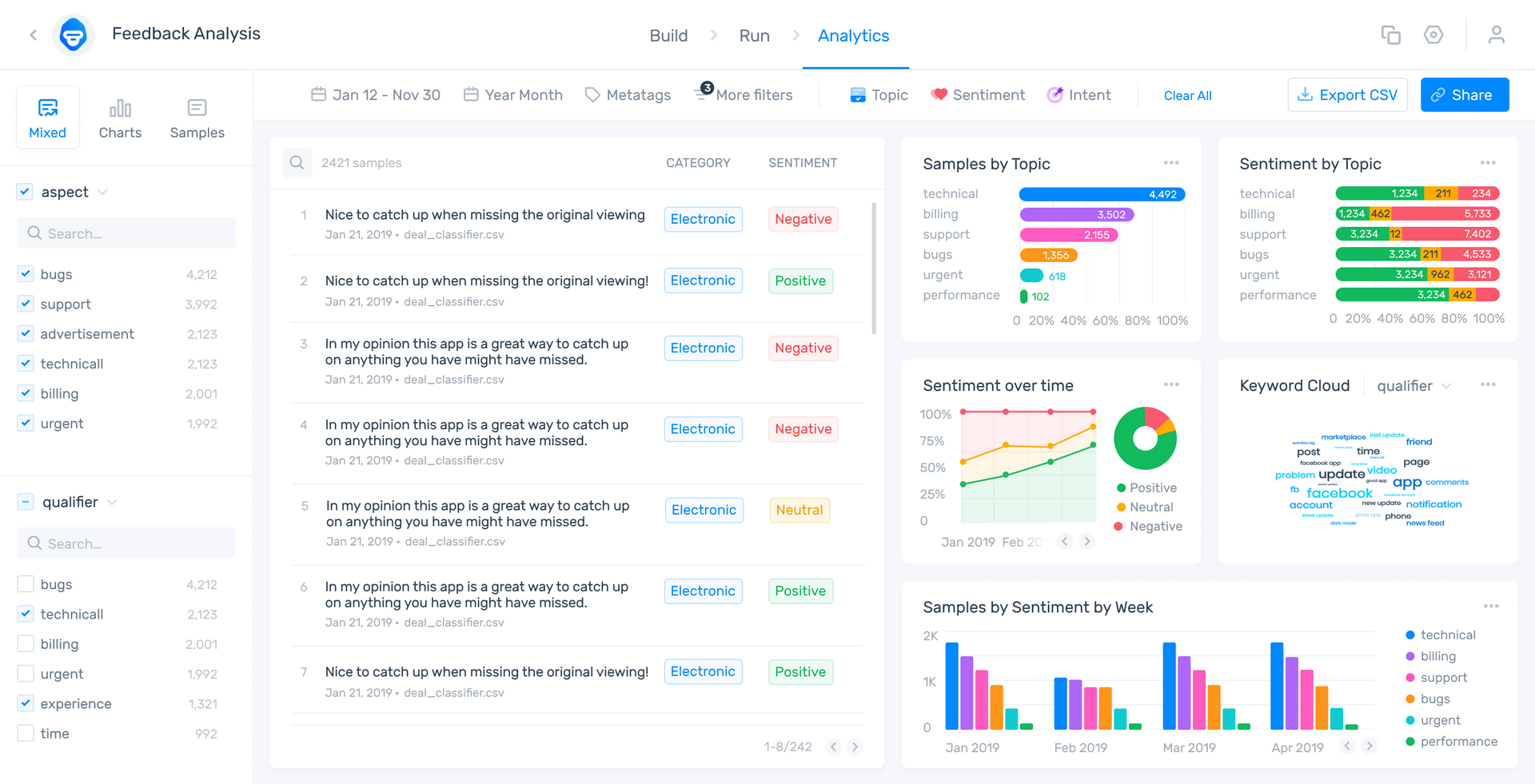Voice of Customer Research For the New Digital Norm

As consumers have more access to more products across the globe and we become more digitally interconnected, customer opinions about any given business have become more important and more visible to other potential customers (on review sites, social media, etc.).
This means that companies need to focus more closely on customer feedback and customer happiness, in order to remain relevant in their given industries.
Voice of customer (VoC) is another way of describing customer feedback, but it focuses heavily on how customers talk about your brand, products, and services. In this guide learn how to perform VoC research so you can listen carefully to what your customers have to say.
What Is Voice of Customer Research?
Voice of customer (VoC) research is the process of analyzing customer feedback (both quantitative and qualitative) to follow the customer journey and uncover customer pain points, in order to improve products and services and overall customer satisfaction (CSAT).
The voice of customer research process aims to listen to your customers’ POVs, in their own words, to understand their needs and opinions and find out what your company can do to improve the customer experience (CX) and product experience (PX).
The COVID-19 pandemic has only sped up changes that we were beginning to see in many businesses: more people working from home; more strictly digital customer to business interactions; easier access to more products, worldwide; and on and on – all of which require businesses to be more customer-centric.
These changes in the way companies do business have changed the way they need to perform VoC research, as well – new voice of customer research steps, new VoC data sources, and more.
Furthermore, as more non-essential businesses begin to return to the office, VoE (voice of employee) will become more important than ever, given lingering virus fears and what is expected to be a new norm of hybrid – in-office and remote – working arrangements.
How to Do Voice of Customer Research
Nearly any business can benefit from VoC research, but you need to set your goals first. What do you want your VoC research to divulge? Do you need it for market research? Product research? Do you need to add new features to your product, but you’re not quite sure what your customers need?
1. Gather Your VoC Data
Once you know the questions you need to answer, you can begin the VoC data gathering process.
Surveys are a great opportunity to seek answers to the questions you need to know and CSAT and NPS (Net Promoter Score) surveys are a great place to start. They begin with quantitative questions that are generally multiple choice, Yes/No, or rated on a scale – which are easy to calculate because they correlate directly with numerical values.
CSAT example question: From 1 to 5, how satisfied were you with your experience today?
NPS example question: From 0 to 10, how likely are you to recommend [our brand, products, or services] to a friend or colleague?
In a post-COVID world, as customers spend more time at home, they often spend more time with the products they use, meaning they expect more from the brands they choose and are often harder to please. So it’s important that you perform real-time VoC research with regular surveys.
With easy-to-use and easy-to-implement online survey tools, like Typeform and SurveyMonkey, you can find customers where they live – with surveys that pop up in your app, on your website, in live chat, via email, or wherever you need.
Furthermore, when you leverage machine learning text analysis tools, you can go beyond quantitative data into the qualitative data of open-ended questions for responses in your customers’ own words, offering real feelings and opinions.
2. Analyze & Manage Voice of Customer Data with AI tools
MonkeyLearn is a SaaS text analysis platform with powerful tools that perform much more accurately and consistently than humans ever could, and with very little need for human interaction. Immediate results allow you to implement immediate changes to improve both CSAT and CX, regularly and continuously.
Take a look at this pre-trained survey feedback analyzer that performs topic analysis to automatically tag open-ended survey responses as Customer Support, Ease of Use, Features, or Pricing.
It easily tags the response as Pricing, allowing you to gather your feedback by the topics or aspects you choose and perform further analysis. And, with SaaS platforms like MonkeyLearn, you can custom-train models to the needs, language, and criteria of your business, usually in just a few steps. Take a look at this tutorial with data from SurveyMonkey to find out how.
There’s also a lot of relevant VoC data to be found in your customer service interactions, whether via email, online chat, on your website, etc. However, not only is this useful information for VoC research analysis, but the pandemic has taught us that customers’ expectations of customer support and customer experience have gone through the roof.
- According to a Microsoft report 90% of customers say good customer service is a major factor when considering a business and 58% say they would end a relationship with a company if they don’t receive the service they expect.
- A recent Salesforce survey tells us that 79% of consumers feel that the experience a company provides is just as important as its products or services.
- Zendesk’s CX trends report shows that 64% of customers used a completely new support channel in 2020 and 73% say they’ll continue to use it.
- Social messaging was up 110%
- SMS/Text communication increased by 75%
- In-app messaging went up by 36%
This means you need to implement a seamless, omnichannel support experience for your customers. Not only will this allow you to give better support, but it will be easier to collect the data and ensure that it’s shared across your organization.
Tools like MonkeyLearn can help you build a fully integrated customer support ticket management system to funnel all of your customer support into one place. Other important voice of customer research steps, like creating a customer feedback loop will ensure that you’re collecting the appropriate data and following up with customers to “close the loop” and let them know that you’ve instituted changes based on their feedback, or have at least received and considered it.
Whether requesting support or simply voicing their opinions, social media is another great source of customer feedback, and text analysis tools allow you to collect and analyze it constantly and in real time. Customers most often take to social media when they’re frustrated with a product or service, so you can right wrongs and put out fires when customers complain. However, when you uncover positive comments, they can always be used for free and powerful marketing opportunities.
This Twitter topic analysis tutorial can show you how to create a custom analyzer in just a few steps. But here, we’ll show you how it works with MonkeyLearn’s pre-trained model, using a tweet about a customer’s Apple store experience:
Run the tweet through topic classification and it’s tagged as Customer Support:
Next, we’ll run this through the pre-trained sentiment analyzer to tag the comment as Positive, Negative, or Neutral.
Sentiment analysis is a text analysis technique that allows you to automatically read text for opinion polarity, to understand the feelings and opinions of the commenter. The sentiment analyzer easily tags the text as Positive.
We can take our voice of customer research a step further by combining the two analyses above for aspect-based sentiment analysis. This analysis first breaks paragraphs, comments, even single sentences, into individual opinion units. Each opinion unit is classified by the aspects or categories of your choice, then by sentiment. So we end up understanding which aspects of a business are positive and which are negative.
OPINION UNIT 1 Had the absolute best experience at the #AppleStore today. ASPECT: UX, SENTIMENT: Positive
OPINION UNIT 2 Was genuinely impressed with the level of care and support I received. ASPECT: Customer Support, SENTIMENT: Positive
Aspect-based sentiment analysis is extremely helpful to understand the sentiment across your entire business, dig into the aspects you need to understand the most, or use individual opinion units to promote your positive attributes and improve the negative.
3. Visualize Your Voice of Customer Data
Once you have your voice of customer research process set up, you can dive into visualization tools, like MonkeyLearn Studio. MonkeyLearn Studio is an all-in-one VoC platform for data collection, analysis, and visualization. You just set up your analyses and they all work in concert for powerful, real-time insights to make data-driven decisions.
Take a look at this MonkeyLearn Studio VoC research analysis of customer reviews of Zoom:

MonkeyLearn Studio brings your voice of customer feedback to life in striking detail. The above shows an aspect-based sentiment analysis of each opinion unit separated by aspect categories, Pricing, Functionality, Usability, etc., then sentiment analyzed, so you can see which of Zoom’s aspects customers think are particularly negative and which are positive.
With MonkeyLearn Studio you can run your analysis 24/7 and in real time, and automatically show you the results in an easy-to-use, interactive dashboard. With results that are this simple to understand, it’s easy to track VoC research step-by-step through the entire customer journey and make immediate changes when you need to.
Follow brand sentiment as it changes day-to-day or hour-to-hour. Target individual product features and find out what your customers think about them or find out what features may be lacking. Follow marketing campaigns just as they’re released to see how they’re trending and tweak them when necessary.
Your VoC research possibilities are nearly endless, and you can change analyses and add and remove data right in the dashboard.
Set Up Your Own VoC Research Process
Voice of customer research offers huge opportunities to truly get in the heads of your customers and more thoroughly understand customer needs and opinions. Once your VoC research steps are set up, you’ll get regular, minute-to-minute customer insights to dig into pain points on the customer journey, inform product design, improve customer service, reduce churn, and make your customers happier, overall.
Take a look at the MonkeyLearn Studio public dashboard and try it out to see how it works. You can change the search by category, date, keyword, intent, and more. It can help you understand your customers better and streamline processes.
Check out all MonkeyLearn’s tools to see what they can do for your voice of customer research.
Or sign up for a free MonkeyLearn demo for a walk through the VoC research process.

Tobias Geisler Mesevage
March 25th, 2021





